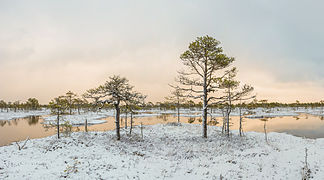Ostrothia
Republic of Ostrothia Ostrii Vabariik | |
|---|---|
| Motto: Isamaa eest! For Fatherland! | |
| Capital and | Rõlva |
| Official languages | Ostrothian |
| Demonym(s) | Ostrothian |
| Government | Unitary Parliamentary Republic |
• President | Artur Jõeäär |
• Prime Minister | Leana Aarma |
| Legislature | Rahvakogu |
| Independence from Republic of Valkea | |
• Tribal Era | 1st Century AD |
• First Crusades | 1217 |
• Duchy of Ostrothia | 1350 |
• Reformation | 1509 |
• National Awakening | 1867 |
• 1905 Revolution | 1905 |
• Valkean Assimilation | 1906-1917 |
• War of Independence | 1917 |
• Republic of Ostrothia | 1923 |
| Area | |
• | 63,400 km2 (24,500 sq mi) |
| Population | |
• Estimate | 2,890,000 |
| GDP (PPP) | 2021 estimate |
• Per capita | $52,543 |
| GDP (nominal) | estimate |
• Total | $58.97 billion |
• Per capita | $25,752 |
| Gini (2021) | 38.4 medium |
| Currency | Ostrothian Mark (OMK) |
| Date format | yyyy-mm-dd |
| Driving side | right |
| Calling code | +530 |
Ostrothia (Ostrothian: Ostrii), officially the Republic of Ostrothia (Ostrothian: Ostrii Vabariik), is a country in Astyria. Ostrothia covers a total area of 63,400 km2 (24,478 sq mi), and is influenced by a humid continental climate. Ostrothia is a member of the Lorecian Community. Rõlva, the capital of Ostrothia and Laadu are the largest cities and urban areas in the country. Other notable cities include Haku, Novessaare, Jõhku and Soulu. The official language of the country, Ostrothian, is a Valkenic language.
Ostrothia has been settled since 10,000 BC. In the first century AD counties known as Maakond were formed which were frequently raided by Vikings who founded the modern Ostrothian capital of Rõlva. Valkean crusades brought christianity to Ostrothia and by the 14th cemtury most of Ostrothia was under Valkean rule in the form of The Duchy of Ostrothia which was established in 1350. In the early 1500's the rerformation brought lutheranism to Ostrothia. In the 1860's the National Awakening saw the reemergence of the Ostrothian language and Ostrothian culture. This culminated in the 1905 revolution in which Ostrothian nationalists attempted to create an Ostrothian Republic. The revolution ended in 1906 as Valkea assimilated Ostrothia into Valkea proper. The Ostrothian language and national symbols such as the Ostrothian triband were banned. This caused Ostrothian nationalism to rise. In 1916 as Valkea fell into civil war Ostrothian nationalists claimed independence. The Valkean army invaded in early 1917 and the Ostrothian war of Independence insued. It lasted until August of that year as the Valkean armed forces was forced to focus on the civil war in Valkea. Ostrothia became a de facto independent state not gaining full recognition from the Valkean government as independent until 1923. Ostrothia joined the Lorecian Community in 1997.
History
Geography
Climate
Politics
 |

|
| Artur Jõäär President |
Leana Aarma Prime Minister |
Since gaining its independence in 1923 Ostrothia has been a Parliamemtary Unitary republic. The Ostrothian head of state is the President. The Presidency of Ostrothia is a completely ceremonial role and the President has no say in the actual running of the country, the role of the President is simply to represent Ostrothia as a figurehead. The head of the executive government of Ostrothia is the Prime Minister who along with his/her cabinet is charged with drafting legislation to the Ostrothian Unicameral parliament the Rahvakogu. The Rahvakogu was first formed in 1918 and is made up of 190 members who are responsible for voting for legislation drafted by the executive government. To gain a majority in the Rahvakogu a party must win 95 seats, the current party in power is Solidaarsus ha Isamaa. The Rahvakogu is elected by all Ostrothian citizens over the age of 18 by universal suffrage every 5 years. The Rahvakogu has been dominated by centre-left parties for the past 30 years. The judiciary branch of the Ostrothian government is split into high or national courts and then further into municipal courts.
Administrative divisions
Foreign relations
As a member of several international organisations such as the Lorecian Community and having been one of the founders of the Vinstrian Union Ostrothia has insured that it, although a small nation, plays a large hand in the geopolitical happenings in the region around it and on the international stage. Ostrothia was a founding member of the Vinstrian Union in the mid 1980’s along with Valkea, Caledonia and Nynorsk Ostlijord. Ostrothia became a member of the Lorecian Community in 1997. Its membership in the community has been invaluable to the nations influence on the international stage. Although relations were strained historically between Valkea and Ostrothia the two have bridged the divide that was caused by Ostrothia’s independence from Valkea in 1923.
Military
Being a small country, Ostrothia does not have a particularly large military. The military that Ostrothia does have is mainly used as a peacekeeping force in international incidents. The Ostrothian military is made up of the Air Force, the Land Forces and the Ostrothian Navy. Historically Ostrothia was under the rule of Valkea and thus was under the control of its armed forces. When Ostrothian independence occurred in 1923 Valkean regiments then stationed in Ostrothia were allowed to remain there insuring that Ostrothia had a force to protect it.
Law enforcement in Ostrothia is the job of the Ostrothian Police who are also in charge of citizenship matters such as Passports and ID cards. The Ostrothian police are a national force split into several smaller forces based on the counties of Ostrothia.
Economy
Ostrothia is a High income market economy. Ostrothia was a relatively small economic power in its area until its membership of the Lorecian Community which has seen a large growth in the Ostrothian economy. Ostrothia is known for having one of the lowest corporate teaxes in Lorecia and for the ease of doing business in the country. Due to its relatively low lying landscape the main exports of Ostrothia include many agricultural prosucts such as cereals. As well as this Ostrothia is a known exporter of electronics, fish and is known for its shipbuilding. Ostrothia is reliant on imports of oil and gas for its energy supply. Ostrothia has a high consumption of energy due to its climate which demnands usage gor heating and so on.
Transport
Ostrothia has an extensive road and rail network that traverses nearly the entire country. The roads in Ostrothia are split into three branches, Motorway, A-Road and B-Road. The majority of freight going through Ostrothia is carried by rail. Rail lines are run by the state owmed service OR. Among passenger trains the most used in the Ostrothian Highspeed Coastal Route which connects the Ostrothian capital Rõlva to Valkea in the north through Haku and through the city of Varju in the south to the Aurora Confederacy. Other major lines include the Rõlva-Laadu highspeed line. In urban areas in Ostrothia there are several light rail and tram services that traverse the cities of Rõlva, Laadu, Jõhku and Varju. Ostrothia has several large ports the largest being the Port of Rõlva followed closely by the port of Haku with more than 67% of passenger and commercial traffic filtering through them. Ostrothia has three international airports those being Rõlva International, Laadu and Varju. They serve as a base for the national airline Vinstrii.
Energy
Ostrothia imports a large quantity of Oil and Gas from neighbouring countries such as Caledonia although in recent years there has been a large pushback to this as the Ostrothian government attempts to explore enviromentally friendly green options. In 2015 the government announced its new renewable energy programme which saw wind power increase to 7% of the total energy input in Ostrothia. Ostrothia has a liberalised its emergy market in 2003. There three nuclear power plants in Ostrothia; Prasilimäe, Votkusaa near Noversaare and Leremaa in Lääpe county. Rennovationsare planned to modernise the latter two of these power plants.
Demographics
Cities
Religion
Education
Culture






